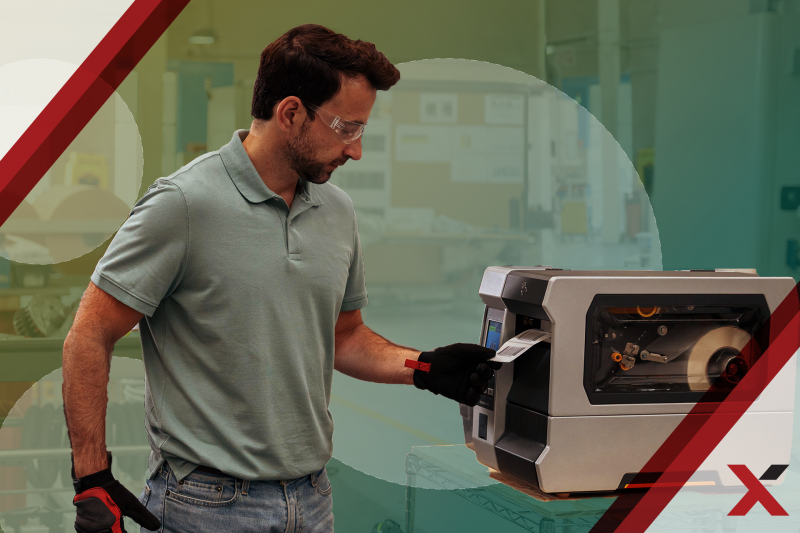Are you wondering which thermal printer is right for you?
Thermal printers are widely used in many industries for their efficiency and reliability in printing labels, receipts, and barcodes. They’re also small units, making them highly portable, which is great in environments where the printer needs to go to the task instead of the other way around.
Understanding how thermal printers work and the differences between direct thermal and thermal transfer printing can help you choose the right solution for your needs.
In this article, we’ll explore these two types of thermal printing technologies, their applications, and how they fit into different industries.
What Are Thermal Printers?
Thermal printers use heat to produce images on paper. Unlike traditional ink-based printers, thermal printers rely on a heat-sensitive process to create prints. They are popular for their speed, durability, and low maintenance requirements. Thermal printers are commonly used for printing labels, receipts, and barcodes in various sectors, including retail, healthcare, and logistics.
Direct Thermal Printing
How It Works
Direct thermal printing involves printing directly onto heat-sensitive paper. The printhead in the printer heats specific areas of the thermal paper to create an image. The paper contains a special coating that changes color when exposed to heat, allowing the printer to produce clear, high-quality images.
Advantages of Direct Thermal Printers
- No Ribbon Required: Direct thermal printers don’t use ink or ribbons, which reduces the cost and complexity of maintenance.
- High-Speed Printing: They are known for their fast printing speeds, making them ideal for high-volume printing tasks.
- Compact Design: Often smaller and more portable, direct thermal printers are suitable for environments with limited space.
Disadvantages of Direct Thermal Printers
- Limited Durability: The print on direct thermal paper can fade over time, especially when exposed to heat, light, or chemicals.
- Thermal Paper Costs: Although the printers themselves may be inexpensive, the cost of thermal paper can add up.
Common Uses of Direct Thermal Printers
- Receipts: Commonly used in point-of-sale (POS) systems for printing customer receipts.
- Shipping Labels: Ideal for creating labels that are used in shipping and logistics.
- Barcodes: Often used in retail and warehousing for barcode labels that need to be scanned quickly.
Thermal Transfer Printing
How It Works
Thermal transfer printing uses a ribbon coated with wax, resin, or a combination of both. During printing, the printhead heats the ribbon, transferring the ink onto the label or paper. The ink from the ribbon bonds to the surface of the label, creating a durable and high-quality print.
Advantages of Thermal Transfer
- Durability: Prints produced with thermal transfer printing are more resistant to fading, smudging, and environmental factors.
- Versatility: Can be used on a wider range of materials, including synthetic labels and various types of paper.
- High-Quality Prints: Capable of producing sharp and clear images, including small text and detailed graphics.
Disadvantages of Thermal Transfer
- Higher Operating Costs: Requires ribbons and sometimes special label materials, which can increase operating costs.
- Maintenance: May need more maintenance compared to direct thermal printers, as it involves changing ribbons and possibly adjusting settings.
Common Uses of Thermal Transfer Devices
- Branding Labels: Used for product labeling where high-quality, long-lasting prints are necessary.
- Pill Labels: Essential in the healthcare industry for printing durable labels on medication bottles.
- Asset Tracking: Utilized in warehouses and logistics for tracking inventory and assets with durable barcode labels.
Applications for Thermal Printers
Recommended for Retail: Thermal Transfer
In retail, thermal printers are essential for printing receipts, price tags, and barcodes. Direct thermal printers are often used at checkout counters for quick receipt printing.
You might prefer a thermal transfer printer for longer-lasting labels, such as those for products or inventory. Thermal transfer printers tend to be more durable, so the device itself will probably withstand heavier use.
Recommended for Healthcare: Thermal Transfer
In the healthcare industry, thermal printers play a crucial role in managing patient information, labeling medications, and tracking medical equipment. Accurate and durable labeling is vital in healthcare to ensure patient safety and regulatory compliance. This makes thermal transfer a better choice for healthcare providers.
Thermal transfer printers work well for pill labels and other medical labels that need to withstand harsh conditions, such as exposure to chemicals and moisture.
Recommended for Logistics and Shipping: Both
Thermal printers are widely used in logistics and shipping for creating shipping labels, barcodes, and inventory tags. Shippers and logistics companies prefer direct thermal printers because of their speed and efficiency in generating shipping labels.
That said, thermal transfer printers are also used in shipping and logistics, for labels that need to endure weather conditions and wear during handling and shipping.
Recommended for Manufacturing: It Depends
In manufacturing, folks use both types of thermal printers for labeling products, packaging, and managing inventory.
The choice between direct thermal and thermal transfer printing depends on the specific needs of your operation – such as the type of material you’re labeling and the required durability of the print.
Choosing the Right Thermal Printer
Selecting the right thermal printer depends on your specific needs, your printing environment, and the materials you’re printing on. Direct thermal printers are great for applications requiring fast, cost-effective printing, and thermal transfer printers are ideal for situations where durability and high-quality prints are key.
Our expert advisors can help you choose the right devices for your operation. We’re 100% brand neutral, so we’re not servants of any one model or brand – our only goal is to find you the right fit for your business needs. Reach out to us today and get all your questions answered.
